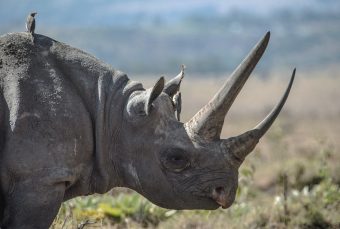
Overall rhino poaching rates have declined since 2018, and trade data suggests the lowest annual estimate of rhino horns entering illegal trade markets since 2013, according to a new report by the IUCN SSC African and Asian Rhino Specialist Groups and TRAFFIC for the 19th meeting of the Conference of the Parties to the Convention on International Trade in Endangered Species of Wild Fauna and Flora (CITES), which will be held in Panama in November this year.
Populations of the Critically Endangered Black rhino across Africa have increased by just over 12 per cent between 2018 and 2021, from 5,495 to 6,195 individuals.
Due to ongoing poaching pressure, Africa’s overall White rhino population has declined by almost 12 per cent, from 18,067 to 15,942 individuals, between 2018 and 2021.
“The overall decline in poaching of rhinos is encouraging, yet this remains an acute threat to the survival of these iconic animals,” said Sam Ferreira, Scientific Officer with the IUCN SSC African Rhino Specialist Group. “To support the growth of rhino numbers, it is essential to continue active population management and anti-poaching activities for all subspecies across different range states.”
More:
The report finds that rhino poaching rates in Africa have continued to decline from a peak of 5.3 per cent of the total population in 2015 to 2.3 per cent in 2021. At least 2,707 rhinos were poached across Africa between 2018 and 2021, accounting for both the white rhino (Ceratotherium simum), which is Near Threatened on the IUCN Red List of Threatened Species, and the rarer Critically Endangered black rhino (Diceros bicornis).
South Africa accounted for 90 per cent of all reported cases, predominantly affecting white rhinos in Kruger National Park, home to the world’s largest white rhino population. As a result, overall white rhino numbers on the continent have declined by almost 12 per cent during this period, while populations of black rhino increased by just over 12 per cent.
Overall, Africa’s rhino population declined around 1.6 per cent per year, from an estimated 23,562 individuals in 2018 to 22,137 at the end of 2021.
According to the report, global lockdowns and restrictions due to the COVID-19 pandemic saw several African countries experience dramatically reduced poaching rates in 2020 compared to previous years. South Africa lost 394 rhinos to poaching in 2020, while Kenya recorded no rhino poaching that year. However, as COVID-19 travel restrictions lifted, some range states reported new increases in poaching activities – for example, South Africa reported 451 and Kenya six poached rhinos in 2021. However, these numbers are still significantly lower than during the peak in 2015, when South Africa alone lost 1,175 rhinos to poaching.
Source: IUCN

